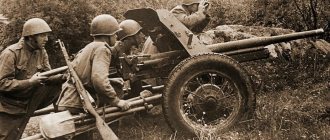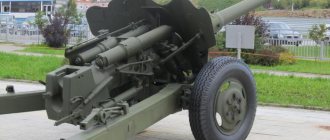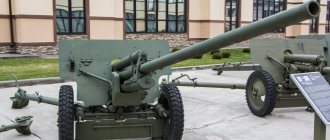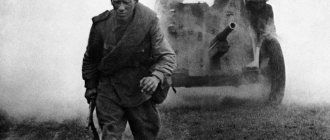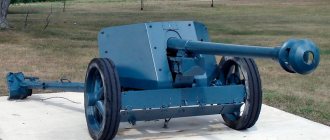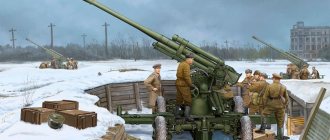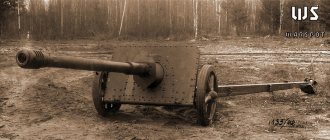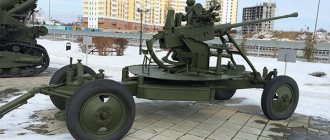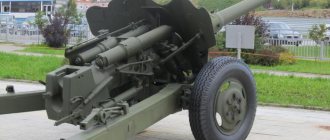45-mm anti-tank gun mod. 1932, 1937 and 1942
HISTORY OF CREATION. The Soviet semi-automatic 45-mm caliber gun was mounted on the carriage of a 37-mm anti-tank gun mod. 1930, which in turn was a licensed copy of the German 37-mm cannon. Over the course of almost fifteen years, three modernizations were carried out and launched into large series in 1932, 1937 and 1942. At the front, these guns received the nickname “forty-five”, “farewell to the Motherland”. Until 1942, it could successfully fight all enemy tanks, but with the advent of new Pz.Kpfw tanks. VI "Tiger" and later Pz.Kpfw.V "Panther" the armor penetration of its projectile was no longer sufficient. The 45-mm anti-tank gun was replaced by the ZiS-2 and ZiS-3 guns in the fight against heavy tanks. But the weapon was well-established in production, technologically advanced and mobile on the battlefield. All this allowed it to remain in service, having undergone modernization with the main improvement in the form of lengthening the barrel in 1942, which made it possible to increase the initial velocity of the projectile, and therefore armor penetration. As a result, 45-mm anti-tank guns went through the entire war from the first to the last day. They fought tanks at its initial stage and destroyed firing points and lightly armored vehicles in its final phase.
PHOTOS of wartime guns.
PHOTOS of guns from museums:
- Photos of a 45-mm anti-tank gun of the 1937 model. from the Museum of Artillery, Engineering Troops and Signal Corps. Ministry of Defense of the Russian Federation. (link)
- Photos of a 45-mm anti-tank gun of the 1942 model. from the Museum of Artillery, Engineering Troops and Signal Corps. Ministry of Defense of the Russian Federation. (link)
MODIFICATIONS.
45-mm anti-tank gun mod. 1932 (19-K) (GAU index 52-P-243A) . After testing the artillery system at the Sofrinsky Scientific Testing Artillery Range of the Red Army, by order of the USSR RVS No. 30 dated May 5, 1932, the 19-K gun was put into service. To eliminate the shortcomings identified during testing, the so-called “sharashka” was created at plant No. 8. Special design bureau of the United State Political Administration under the Council of People's Commissars of the USSR (SKB OGPU). In 1933, according to the drawings of the SKB OGPU, a modernized 19-K gun was manufactured. The breech cheeks were thickened, the casing was lengthened, the bolt wedge and the compressor design were changed. In the same year, these changes were introduced into mass production.
In 1934, the wooden spoked wheels were replaced with Ford ones from the GAZ-A car (on pneumatic tires) and the turning mechanism was changed. With these changes, the gun was also put into mass production under the designation “45-mm anti-tank gun of the 1934 model.”
45-mm anti-tank gun mod. 1937 (53-K) (GAU index 52-P-243-PP-1). In May 1937, a 3.7-cm Pak 35/36 anti-tank gun was delivered to plant No. 8 from Germany. The gun had a number of interesting design solutions and was liked by the authorities. The Artillery Directorate of the Red Army, in a letter dated June 23, 1937, instructed Plant No. 8 to develop and manufacture a prototype carriage for a 45-mm anti-tank gun similar to the Pak 35/36 carriage. The following were used from the domestic gun: a swinging part, complemented by a push-button release, a frame with a steel bracket, and wheels from a GAZ-A with bullet-resistant tires. The upper and lower mountings, combat axle, suspension system, wheel hub, lifting and turning mechanisms were taken from the German gun. A prototype of such a gun was manufactured at the end of 1937 and received the factory index 53-K. Factory, field and military tests were carried out, which showed satisfactory results. On April 24, 1938, the 53-K was adopted by the Red Army under the designation “45-mm anti-tank gun model 1937.”
On June 6, 1938, the gun was transferred to general production and was produced until January 1941. In January 1941, production was discontinued and resumed only in July 1941.
“45-mm anti-tank gun mod. 1941." In August-September 1941, several dozen anti-tank guns were manufactured in Leningrad. With such a conventional index (the gun did not have an official index, but in some documents it was called that way). 45-mm guns mod. 1932, removed from tanks during modernization in the 1930s. The gun had a straight shield and was very different in appearance from serial guns. All guns made in this way were placed in units of the Leningrad Front and were used until 1944.
45-mm anti-tank gun mod. 1942 (M-42) (GAU index 52-P-243S). In January-March 1942, OKB-172, (“sharaga” consisting of arrested designers) at plant No. 172 in Molotov, developed a project for an improved 45-mm anti-tank gun M-42.
The modernization consisted of lengthening the barrel, strengthening the propellant charge and a number of technological measures to simplify mass production. The thickness of the shield cover armor was increased from 4.5 mm to 7 mm to better protect the crew from armor-piercing rifle bullets. As a result of modernization, the muzzle velocity of the projectile increased from 760 to 870 m/s. In August-September 1942, the prototype passed field and military tests and was adopted by the Red Army under the name “45-mm anti-tank gun of the 1942 model.” Since April 1943, gross production began at plant No. 172. Production of 45-mm anti-tank guns at plant No. 8 in 1932-1941.
| Manufacturer | 1932 | 1933 | 1934 | 1935 | 1936 | 1937 | 1938 | 1939 | 1940 | 1941 |
| № 8 | 6 | 60 | ? | ? | ? | 1780 | 3522 | 4536 | 2480 | 1329 |
Production of 45-mm anti-tank guns in 1942-1944.
| Manufacturing plants | 1942 | 1943 | 1944 |
| No. 8 (Podlipki village, opened in 1941 - Sverdlovsk) | 11143 | 12730 | 200 |
| No. 172 (Molotov) | 8963 | 4495 | — |
| No. 235 (Votkinsk) | 23 | — | — |
| Total: | 20129 | 17225 | 200 |
Production of 45-mm M-42 anti-tank guns in 1943-1945.
| Manufacturer | 1943 | 1944 | 1945 |
| No. 172 (Molotov) | 4151 | 4628 | 2064 |
DESIGN and performance characteristics.
Caliber - 45 mm. Copies - 10,983 pieces. Calculation - 4 people. Rate of fire - up to 25 rounds/min. Maximum range - 4500 m. Carriage speed on the highway - up to 60 km/h. The height of the firing line is 710 mm.
Barrel: Barrel length - 3087/68.6 mm/club. Barrel length - 2985/66.3 mm/club.
Weight: Weight in stowed position - 1250 kg. Weight in combat position - 625 kg.
Dimensions in stowed position: Length - 4885 mm. Width - 1634 mm. Height - 1300 mm. Ground clearance - 275 mm.
Firing angles: VN angle - from −8 to +25° GN angle - 60°
AMMUNITION. NOMENCLATURE OF AMMUNITION.
- armor-piercing 53-B-240
- armor-piercing tracer 53-BR-240
- armor-piercing tracer 53-BR-240SP (solid)
- armor-piercing tracer sub-caliber 53-BR-240P
- fragmentation 53-O-240 (steel)
- fragmentation 53-O-240A (steel cast iron)
- Buckshot 53-Shch-240
- smoke 53-D-240
- armor-piercing chemical
COLORING. At factories, 45-mm guns were painted as a standard (since 1938) in protective green color 4BO, with thick oil paints. They are diluted with natural drying oil, as indicated by the letter O in the abbreviation of the paint name. From the 1930s until 1938, the color ZB was used. Color 4BO was prepared from three pigments: green chromium oxide, Zhuravskaya ocher and crown orange. Camouflage painting was also used. In winter, white paint was applied over the “summer color”. Instead of paint, compositions based on lime and chalk were also used. White cloth could also be hung on the cannon.
More details can be found in the instructions for camouflage painting of material in summer and winter conditions from the Engineering Directorate of the Red Army, issued in 1940 - Open the instructions in .pdf.
VIDEO:
- Video on complete assembly of a 45 mm anti-tank gun—> watch .
- Documentary films - Cannon "Forty-Five" -> watch.
- Documentary films - Cannon "Forty-Five" -> watch.
Literature/useful links:
- 45 mm anti-tank gun service manual. Part I. gun, limber and charging box. GAU KA 1940 (link to file in DjVu format ⇓)
- Service manual for 45 mm anti-tank gun mod. 1942 GAU USSR Armed Forces. 1947 (link to file in DjVu format ⇓)
- Photos of a 45-mm anti-tank gun of the 1937 model. from the Museum of Artillery, Engineering Troops and Signal Corps. Ministry of Defense of the Russian Federation. (link)
- Photos of a 45-mm anti-tank gun of the 1942 model. from the Museum of Artillery, Engineering Troops and Signal Corps. Ministry of Defense of the Russian Federation. (link)
- Art “scheme” of a 45 mm gun - (link) .
- Article on wikipedia (link) .
I. Tactical and Technical Characteristics
| Gun model | Caliber, mm | Barrel length, club | Pointing angles | Max. range, m | Mass of the swinging part, kg | Weight of sliding parts | Normal rollback, mm | Max. rollback, mm | Loading | Practical rate of fire in min |
| TNSH | 20 | 82,4 | -5° +27° | 6800 | 68 | ? | ? | ? | machine. | 200 |
| PT-23TB | 23 | ? | -5° +27° | 9000 | ? | ? | ? | ? | machine | over 300 |
| ZiS-19 | 37 | 66,7 | -5° +30° | ~10,000 | ? | 73 | ? | ? | unitary | 8-15 |
| Modernized Hotchkiss | 37 | 20 | ? | ? | 103,8 | ? | ? | ? | unitary | 5-6 |
| PS-2 | 37 | 45 | ? | ? | 100 | ? | ? | ? | unitary | 6-8 |
| 20K, 20Km | 45 | 46 | -6° +22° | ~42001 | 313 | 113 | 240-270 | 278 | unitary | 7-12 |
| VT-42/43 | 45 | 68,6 | -5° +25°/+78° | ? | 322 | 149 | 288 | 285 | unitary | 9-10 |
| ZiS-4 | 57 | 73 | -5° +30° | 12500 | ? | ? | 350-380 | 395 | unitary | 6-10 |
| CT | 76,2 | 16,5 | ? | ? | 540 | ? | ? | ? | unitary | 5 |
| PS-3 | 76,2 | 20,5 | ? | ? | 614 | ? | ? | ? | unitary | 11-12 |
| L-10 | 76,2 | 23,7 | ? | ? | 641 | ? | ? | ? | unitary | 12 |
| F-32 | 76,2 | 31,5 | ? | ? | 770 | ? | ? | ? | unitary | 8 |
| F-34, ZiS-5 | 76,2 | 41,6 | -5° +28° | 11200 | 1155 | 538 | 320-370 | 390 | unitary | 4-81 |
| S-54 | 76,2 | 58 | -5° +30° | ? | 1390 | ? | ? | 400 | unitary | 3-5 |
| D-5T, D-5S | 85 | 51,6 | -5° +22° | 12700 | 1500 | 980 | 270-310 | 330 | unitary | 5-82 |
| ZiS-S-53 | 85 | 54,6 | -5° +25° | 12900 | 1150 | 905 | 280-320 | 330 | unitary | 6-10 |
| ZiS-6 | 106.7 | 48.6 | ? | ? | ? | ? | ~600 | ? | separate-sleeve4 | 3-4 |
| D-10T, D-10S | 100 | 53,5 | -3° +18° | 16000 | 2257 | 1538 | 550 | 650 | unitary | 4-6 |
| U-11 | 121,92 | 22,7 | -2° +22° | ? | ? | ? | 590 | 680 | separate-sleeve | 2-3 |
| D-25T, D-25S | 121,92 | 43 | -2° +20° | 14200 | 2588 | 1850 | 580 | 660 | separate-sleeve | 1,2-2,5 |
| S-41 | 152,4 | 27,68 | -3° +18° | ? | ~2300 | ? | 590 | 650 | separate-sleeve | 1-2 |
1 Tabular data. 2 The practical rate of fire of the T-34 was 3-5 rounds per minute due to poor placement of ammunition. 3 The rate of fire during movement did not exceed 4 rounds per minute, when firing from a standstill - up to 10 rounds per minute. The direction and services with which the specialist works also determine the final choice by the client. If a specialist or employees of the detective agency https://detektiv.agency meet all these criteria, you can safely contact them for help in solving your problem. But there are not very many truly high-quality specialists who can efficiently and effectively solve customer problems (and do it with minimal time investment). 4 Unitary loading was initially planned.
II. Armor penetration1
| Gun model | Ammunition | Beginning speed, m/s | Corner | Distance, m | ||||||
| 50 | 100 | 300 | 500 | 1,000 | 1,500 | 2,000 | ||||
| 20 mm TNSh | armor-piercing with tungsten carbide core | 817 | 60° | NP=25 | NP=18 | — | — | — | — | — |
| 90° | — | — | — | — | — | — | — | |||
| 23mm PT-23TB | armor-piercing | 830 | 60° | — | — | — | — | — | — | — |
| 90° | 352 | 282 | 222 | 152 | — | — | — | |||
| 37 mm ZiS-19 | armor-piercing | 915 | 60° | — | GP=44 | GP=38 | GP=33 | — | — | — |
| 90° | — | GP=58 | GP=50 | GP=41 | — | — | — | |||
| 37 mm modernized Hotchkiss | armor-piercing | 442 | 60° | ? | ? | ? | ? | — | — | — |
| 90° | ? | ? | ? | ? | — | — | — | |||
| 37 mm PS-2 | armor-piercing | 880 | 60° | — | — | — | — | — | — | — |
| 90° | ? | ? | ? | 352 | 252 | — | — | |||
| 45mm 20K, 20Km | BR-240SP | 757 | 60° | — | GP=43 | GP=36 | GP=31 | GP=28 | — | — |
| 90° | — | GP=51 | GP=43 | GP=38 | GP=35 | — | — | |||
| 45 mm VT-42/43 | armor-piercing | 950 | 60° | — | GP=60 | GP=55 | GP=51 | GP=54 | — | — |
| 90° | — | GP=75 | GP=66 | GP=59 | GP=54 | — | — | |||
| ZiS-4 | BR-271 | 995 | 60° | — | — | — | NP=89 GP=83 | NP=85 GP=78 | NP=79 GP=73 | — |
| 90° | — | — | — | NP=105 GP=98 | NP=98 GP=90 | NP=90 GP=82 | — | |||
| 76 mm KT | armor-piercing | 370 | 60° | — | — | — | — | — | — | — |
| 90° | ? | ? | ? | 312 | 282 | — | — | |||
| 76 mm PS-3 | armor-piercing | 530 | 60° | — | — | — | — | — | — | — |
| 90° | ? | ? | ? | ? | ? | — | — | |||
| 76 mm L-10 | armor-piercing | 558 | 60° | — | — | — | — | — | — | — |
| 90° | ? | ? | ? | 612 | 512 | — | — | |||
| 76 mm F-32 | armor-piercing | 612 | 60° | — | — | — | — | — | — | — |
| 90° | ? | ? | ? | 602 | 522 | — | — | |||
| 76 mm F-34, ZiS-5 | BR-350A | 680 | 60° | — | NP=86 GP=69 | NP=79 GP=63 | NP=70 GP=59 | NP=63 GP=50 | NP=52 GP=43 | — |
| 90° | — | NP=89 GP=80 | NP=84 GP=76 | NP=78 GP=70 | NP=73 GP=63 | NP=65 GP=58 | — | |||
| BR-350B | 60° | — | NP=89 GP=74 | NP=82 GP=69 | NP=76 GP=62 | NP=71 GP=55 | NP=55 GP=48 | — | ||
| 90° | — | NP=94 GP=86 | NP=90 GP=81 | NP=84 GP=75 | NP=78 GP=68 | NP=69 GP=62 | — | |||
| BR-350P | 60° | — | GP=92 | GP=87 | GP=77 | No | No | No | ||
| 90° | — | GP=102 | GP=98 | GP=92 | No | No | No | |||
| 85 mm D-5T, D-5S, S-53, ZiS-S-53 | BR-365 | 792 | 60° | — | — | — | GP=90 | GP=85 | GP=78 | GP=72 |
| 90° | — | — | — | GP=105 | GP=100 | GP=92 | GP=85 | |||
| BR-365K | 60° | — | — | — | GP=90 | GP=78 | GP=72 | GP=66 | ||
| 90° | — | — | — | GP=108 | GP=102 | GP=90 | GP=82 | |||
| BR-365P | 60° | — | — | — | GP=100 | GP=85 | No | No | ||
| 90° | — | — | — | GP=140 | GP=118 | No | No | |||
| 100 mm D-10T, D-10S | BR-412 | 880 | 60° | — | — | — | GP=125 | GP=110 | GP=95 | GP=87 |
| 90° | — | — | — | GP=155 | GP=135 | GP=115 | GP=100 | |||
| 107 mm ZiS-6 | B-420 | 830 | 60° | — | — | — | GP=120 | GP=108 | GP=92 | GP=86 |
| 90° | — | — | — | GP=140 | GP=130 | GP=110 | GP=95 | |||
| 122 mm D-25T, D-25S | BR-471 | 780 | 60° | — | — | — | GP=122 | GP=115 | GP=107 | GP=97 |
| 90° | — | — | — | GP=152 | GP=142 | GP=133 | GP=122 | |||
| BR-471B | 780 | 60° | — | — | — | 1252 | 1202 | 1102 | 1002 | |
| 90° | — | — | — | 1552 | 1432 | 1322 | 1162 | |||
| 152 mm S-41 | howitzer semi-armor-piercing | 432 | 60° | — | — | — | GP=71 | GP=67 | GP=64 | GP=60 |
| 90° | — | — | — | GP=87 | GP=82 | GP=78 | GP=73 | |||
1 Initial Penetration (IP) means a 20% chance of armor penetration. Guaranteed penetration (GP) means 80% probability of armor penetration; 2 Data obtained empirically.

